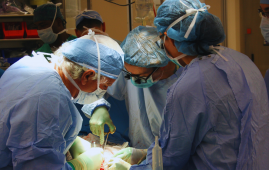

It’s rare for the same medication to be used for both medicinal and cosmetic purposes. But bimatoprost (also sold under the name brand Latisse®) pulls double duty. In addition to treating glaucoma, it can be used to grow and thicken eyelashes.
It’s effective for both purposes, but is it safe? Can it cause lasting changes to your eyes? The answer to both questions, according to ophthalmologist Julian Perry, MD, is yes.
“You must remember to follow the administration instructions as specified if you want to lower the risk of any side effects,” he says. “If you use it properly, you’re exposing the eye to only 5% of the drug as compared to the eye drop method used to treat glaucoma.”
Hormone-like effects
On its own, bimatoprost is a prostaglandin – a fatty acid that has hormone-like effects on the body. As an eye drop medication, it’s used to treat glaucoma by relieving the pressure inside the eye.
It should be noted however that this fatty acid can cause light irises to become darker over the years. For example, it can cause permanent brown discoloration of the iris over months or years of use. Another side effect is known as periorbital fat atrophy – a hollowing-out appearance of the eyelids. This fat atrophy is permanent and can be severe, so you should stop using it immediately if you notice symptoms.
In an eyelash grower, however, bimatoprost’s function and effects are slightly different.
How an eyelash grower works
Before application, wash your hands and face, removing any makeup. The solution is used once nightly and is placed at the roots of the upper eyelashes with a single-use applicator. It works by creating more hair follicles during the hair-growing cycle.
Latisse is approved by the U.S. Food and Drug Administration (FDA) for use on the upper eyelashes only. It may spread to the lower lashes as you blink, but the primary effect will be on the upper eyelashes only. Don’t worry if any medication gets into your eye, Dr. Perry says, as it’s used to treat glaucoma and is unlikely to cause damage.
Results usually appear within two months. If you stop using eyelash grower, your eyelashes will gradually return to their original state.
Safe for most users
The FDA approved Latisse for eyelash growth in 2008, and it’s deemed safe for adults. Because bimatoprost is the main ingredient, if you have glaucoma and are already treating it with medication, consult your ophthalmologist before using Latisse, Dr. Perry says.
In particular, mention if you’re already using latanoprost or travoprost. Using these drugs in combination with Latisse can increase treatment side effects.
Side effects can fade with this use
While bimatoprost’s side effects are permanent used alone, when used in eyelash grower they can fade when you stop using the product, Dr. Perry says. Patients can experience eyelid itching, dry eye, eyelid darkening and bloodshot eyes. Eye and eyelid swelling, as well as some allergic reactions, are possible, according to the FDA.
More significant reactions include increased eyelash growth in the corners of the eyes and excessive eyebrow growth if the medication touches them.
Report any eye pain, infection or vision changes to your ophthalmologist immediately, Dr. Perry says.
Eyelash grower and contacts
If you wear contacts and want to use Latisse, you should know that the FDA warns that your contacts can absorb the product, which can discolor your contacts. Remove your contacts before you apply the solution, and wait 15 minutes before putting them back in.
more recommended stories
 Safer Allogeneic Stem Cell Transplants with Treg Therapy
Safer Allogeneic Stem Cell Transplants with Treg TherapyA new preclinical study from the.
 Autoimmune Disorders: ADA2 as a Therapeutic Target
Autoimmune Disorders: ADA2 as a Therapeutic TargetAdenosine deaminase 2 (ADA2) has emerged.
 Kaempferol: A Breakthrough in Allergy Management
Kaempferol: A Breakthrough in Allergy ManagementKaempferol, a dietary flavonoid found in.
 Early Milk Cereal Drinks May Spur Infant Weight Gain
Early Milk Cereal Drinks May Spur Infant Weight GainNew research published in Acta Paediatrica.
 TaVNS: A Breakthrough for Chronic Insomnia Treatment
TaVNS: A Breakthrough for Chronic Insomnia TreatmentA recent study conducted by the.
 First-of-Its-Kind Gene-Edited Pig Kidney: Towana’s New Life
First-of-Its-Kind Gene-Edited Pig Kidney: Towana’s New LifeSurgeons at NYU Langone Health have.
 Just-in-Time Training Improves Success & Patient Safety
Just-in-Time Training Improves Success & Patient SafetyA study published in The BMJ.
 ChatGPT Excels in Medical Summaries, Lacks Field-Specific Relevance
ChatGPT Excels in Medical Summaries, Lacks Field-Specific RelevanceIn a recent study published in.
 Study finds automated decision minimizes high-risk medicine combinations in ICU patients
Study finds automated decision minimizes high-risk medicine combinations in ICU patientsA multicenter study coordinated by Amsterdam.
 Study Discovers Connection Between Omicron Infection and Brain Structure Changes in Men
Study Discovers Connection Between Omicron Infection and Brain Structure Changes in MenA recent study in the JAMA.

Leave a Comment